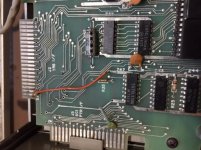I received the floppy drive cable from some Australian guy via ebay. excellent service on that.
i have a known working level 2 16k CPU, CPU->EI buffer cable, two expansion interfaces of unknown status (the cassette relays do click upon power up), and a few floppy drives.
I have it all connected, floppy drive on the first connector nearest EI, power up EI, floppy, CPU. not recognizing EI....simply boots to memory size, level 2 basic.
when I power the EI, I hear a loud click in the drive, like a relay.
Any pointers on where to start diagnosing? From Mav's video, I should see a garbage screen upon successful boot with the EI prior to loading dos.
i have a known working level 2 16k CPU, CPU->EI buffer cable, two expansion interfaces of unknown status (the cassette relays do click upon power up), and a few floppy drives.
I have it all connected, floppy drive on the first connector nearest EI, power up EI, floppy, CPU. not recognizing EI....simply boots to memory size, level 2 basic.
when I power the EI, I hear a loud click in the drive, like a relay.
Any pointers on where to start diagnosing? From Mav's video, I should see a garbage screen upon successful boot with the EI prior to loading dos.


